Experimental Highlights - 2018
March
Searching for an Exotic Phase of Magnesium
Firing up NIF for National Security Applications
NIF’s unprecedented capabilities and versatility enable a broad range of research that focuses on four major mission areas. Fundamental differences, however, typically exist between the Stockpile Stewardship missions of inertial confinement fusion and high energy density science; Discovery Science; and the National Security Applications (NSA) mission.
“NSA is a vehicle for the Department of Defense and other government agencies to do experiments on NIF,” says Brent Blue, the NSA program manager. “We have an open call for proposals, which get peer reviewed. Then, researchers are awarded time. Many of them are not from the Laboratory or even part of the NNSA (National Nuclear Security Administration) complex. Our team helps them execute their experiments.”
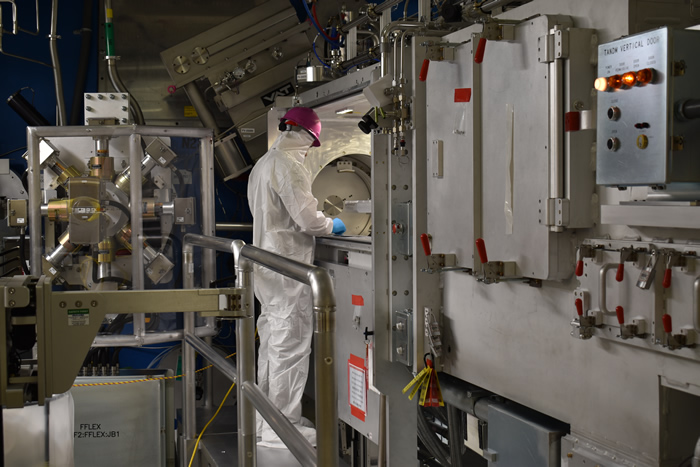 A technician loads NSA diagnostics and samples into a NIF target and diagnostic manipulator (TANDM). Credit: Brent Blue
A technician loads NSA diagnostics and samples into a NIF target and diagnostic manipulator (TANDM). Credit: Brent Blue On average, 30 to 40 NSA shots a year are performed. Livermore, Sandia, and Los Alamos lead some of these experiments as do many other partners, such as the Naval Research Laboratory and agencies as far away as the United Kingdom.
An important subset of the experiments aims at investigating the survivability of components exposed to the extreme environments present during nuclear detonations. In those cases, researchers want to understand how the materials that make up these components will respond. NIF can replicate different types of radiation bombardment in a precisely controlled manner that offers many opportunities for analysis.
“A part might be manufactured in two different ways,” Blue says. “Each looks the same. Some benchtop tests say both perform the same. But under intense radiation environments, will they respond differently? Models might not catch this. However, we can probe for it. The data can then be used to improve the models.”
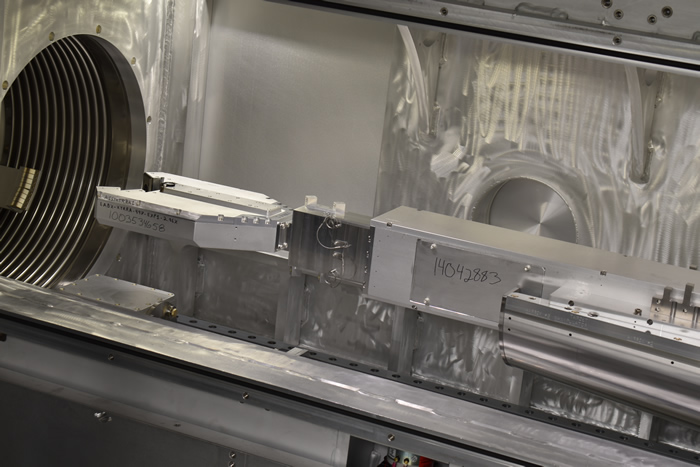 For an NSA shot, samples contained inside a diagnostic “snout” are attached at the end of the TANDM’s arm for insertion into the NIF Target Chamber. Credit: Brent Blue
For an NSA shot, samples contained inside a diagnostic “snout” are attached at the end of the TANDM’s arm for insertion into the NIF Target Chamber. Credit: Brent Blue For other missions, the laser and target interaction during a shot generates conditions, such as plasma and fusion, that are the objects of study. For NSA, the interaction between the laser and target produces a bright (powerful) radiation source that is used to probe and examine samples physically separated from the laser and target. In fact, for many NSA shots a hohlraum containing a fuel capsule is not used.
The samples, which can be 50 millimeters in diameter, remain solid during a shot and never become plasma. Also, as opposed to the other NIF missions that concentrate the laser energy on a target within the first 20 nanoseconds of a shot and nothing remains afterward to examine, the period of interest for NSA shots leans toward microseconds—which could be a sample’s material response time—and could extend out to minutes, days, months, and even later.
“Our samples don’t break apart. They stay together,” Blue says. “We take them out after a shot and do more analysis. So, it is not just the active measurements we make during the shot, but the measurements we take afterward once the samples are back in the lab.”
The diagnostics hold the samples. A probe might be looking at the motion of the rear surfaces of samples to understand how shocks are transmitted. A thermocouple can measure temperature changes. Strain gauges can monitor how samples deform.
“NIF is very good at converting the laser energy into bright sources of x rays,” Blue says. “Imagine a flash of light from a camera, but instead it’s a giant flash made of x rays. We can tune their energy and wavelength. Some researchers might want a specific frequency x-ray line while others might require something that’s broadband. So we can also tune the spectrum.”
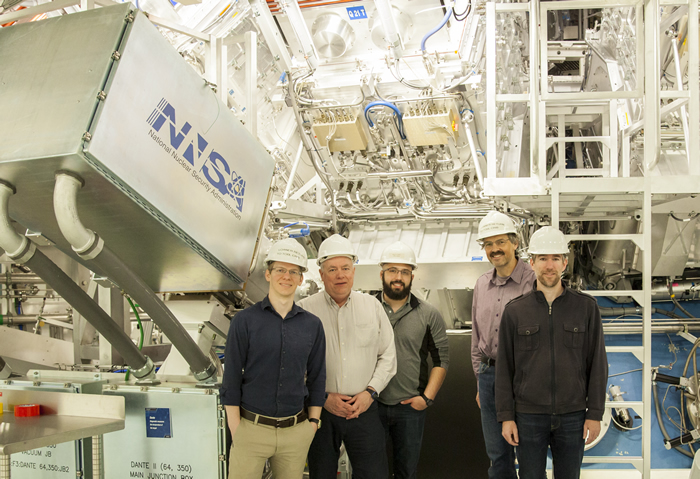 NSA researchers inside the Target Bay (from left:) Patrick Poole (LLNL), George Williams (Peraton), Jacob Pinello (Peraton), Klaus Widmann (LLNL), and Brent Blue (LLNL). Credit: Mark Meamber
NSA researchers inside the Target Bay (from left:) Patrick Poole (LLNL), George Williams (Peraton), Jacob Pinello (Peraton), Klaus Widmann (LLNL), and Brent Blue (LLNL). Credit: Mark Meamber As a megajoule-class laser facility, NIF can produce nanosecond bursts of high energy x-rays. Energy of a few hundred kilojoules can be reached, which is nearly an order of magnitude greater than the next most energetic laser system capable of nanosecond pulses.
These bursts behave like point sources that illuminate everything uniformly inside the Target Chamber, so a sample will only be struck by a portion of the total flux of x rays radiating from the target.
“We position the samples up close to get to the high fluences that are needed. Hefty doses of x rays smack the samples very hard and launch shockwaves through them. Interesting physics happens,” Blue says.
By changing the distance between the target and the samples, the NSA team can match the amount of x-ray energy that researchers require. Samples can be positioned as close as a few centimeters from the target for a very high dose, or more than a meter away where the dose is much lower. One of the diagnostics is so sensitive that it remains outside the Target Chamber, connected by an open gate valve.
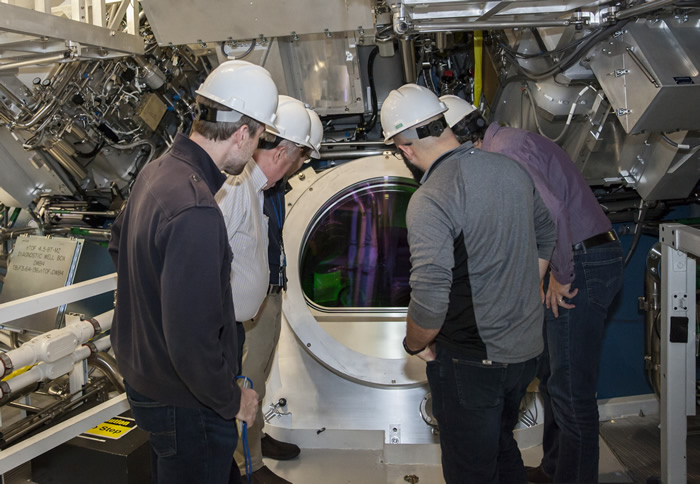 The researchers peer into the Target Chamber as they prepare for their next NSA shot. Credit: Mark Meamber
The researchers peer into the Target Chamber as they prepare for their next NSA shot. Credit: Mark Meamber Once researchers set the requirements for the type of radiation they want to use for their shot, the NSA team matches them up with the right target. When NIF’s laser energy is applied, the immense heat causes the target to emit x rays that are uniquely characteristic of the material making up the target. If x rays with different characteristics are needed, the target material is changed. At about a gram or less, some targets are solids while some are gases.
“In the case of a gas, we have a tube that looks somewhat like a hohlraum,” Blue notes. “It has windows to hold in the gas, and the laser enters at the top and bottom. The gas could be krypton, which would emit x rays at 13 keV (kiloelectron volts). Or xenon can be used to generate 4.5 keV x rays. If it is a solid material, such as silver, we make a thin shell that looks like a soda can. We shine the laser inside, which heats the silver to the point where it emits 22 keV x rays.”
Targets made of low density silver foams, not much denser than air, have also been fielded. Instead of the laser stopping at the surface as with a solid wall, it can propagate through the foam, allowing uniform heating across its volume.
NIF can also generate and tune bright sources of neutrons at 14 megaelectron volts (MeV). Neutrons will pass right though a sample but will still interact with the material. In addition to material science, neutron experiments also investigate damage effects on electronics. A single neutron passing through a transistor is enough to change its performance.
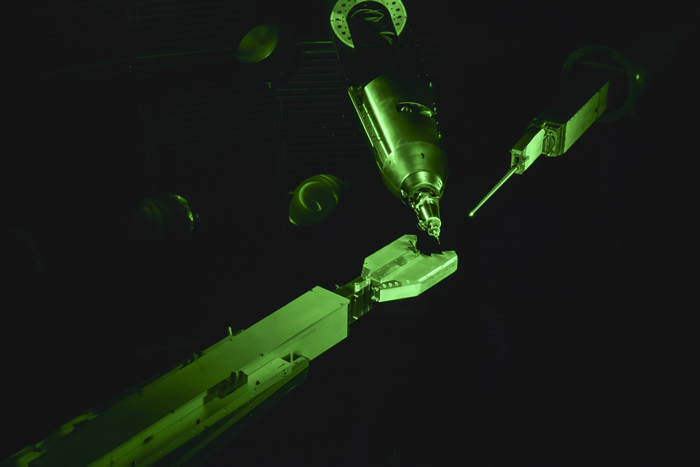 (Above) Positioned inside the Target Chamber are the snout on TANDM (bottom), the target positioner (top left), and a time resolved x-ray spectrometer (top right). (Below) When struck by the laser, a target filled with xenon gas emits x rays at 4.5 keV.
(Above) Positioned inside the Target Chamber are the snout on TANDM (bottom), the target positioner (top left), and a time resolved x-ray spectrometer (top right). (Below) When struck by the laser, a target filled with xenon gas emits x rays at 4.5 keV.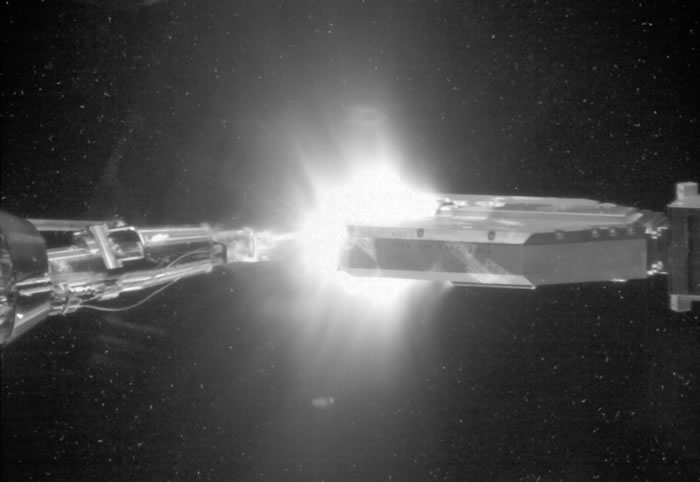
For these shots, the targets from the inertial confinement fusion program are leveraged. NSA shots have used cryogenic, indirectly-driven capsules inside hohlraums to generate neutrons but also have used direct-drive capsules, which are directly impacted by the lasers, for simplicity in fielding.
Another advantage of using NIF is that very little debris is generated during a shot. This is especially important for an experiment using x rays to investigate how shocks are transmitted through a sample. The x rays from the target, followed by target debris, will hit the sample. Too much debris could obscure the signal from the x rays.
“NSA experiments are complex because they are atypical compared to the usual operations of NIF,” says Blue. “The number of people who touch our experiments one way or another to make the shots happen is really quite immense. It takes the full NIF team. We couldn’t do it without everyone pulling together.”
—Dan Linehan
Searching for an Exotic Phase of Magnesium
A NIF Discovery Science campaign conducted by an international team of researchers is aimed at experimentally determining for the first time if magnesium transforms into a series of exotic “electride” structures under the extremely high pressures generated by NIF’s lasers.
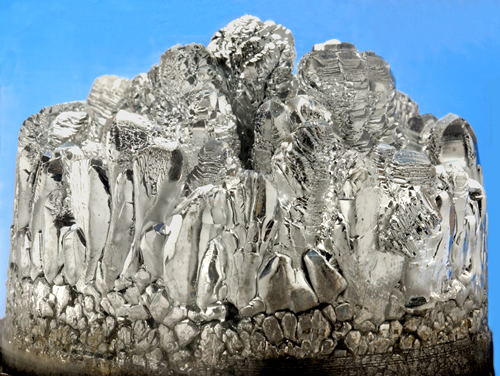 A sample of crystallized magnesium. Credit: CSIRO
A sample of crystallized magnesium. Credit: CSIRO Exposing materials to pressures and temperatures that can be created only on NIF can result in the kinds of phase, or structural, changes that have long been predicted by calculations but until now could not be verified by experiments (see “Putting Pressure on Hydrogen”).
An example is the transition to metallic electride phases predicted to occur in magnesium, a relatively simple, low-Z (low atomic number) element, when it’s subjected to pressures ranging from two to 15 megabars (million atmospheres). The campaign aims to determine whether the predicted phase transition sequence in magnesium is observed experimentally and to determine the structures of the high-pressure phases. Early results indicate that those structures could be somewhat more complex than theory has predicted.
Electride phases are thought to exist in many elements at very high densities, and magnesium is an ideal candidate to verify them, said LLNL physicist Martin Gorman, the NIF liaison to the research team.
“Magnesium has been predicted by theory to exhibit these interesting electride phases at very high pressures,” he said. “There’s a sequence of three successive phase transitions between metallic electride phases at five Mbars, seven Mbars and 12 Mbars, which I believe is the only material predicted to do that. So we could actually study different electride phases within one material.”
Experimenting on other materials predicted to have electride phases, such as alkali metals or aluminum, pose a number of challenges, noted physics professor Malcolm McMahon of Edinburgh University, the campaign’s principal investigator. Alkali metals are highly compressible and reactive and tend to melt under pressure, while aluminum requires much higher pressures—as much as 50 megabars—to reach the electride phase. In addition, McMahon said, the electride phases of the alkali metals have highly complex structures that could be difficult to resolve using diffraction studies.
“It’s the goldilocks effect,” he said. Magnesium is “just the perfect material. The underlying symmetry of the electride phases are predicted to be simple, and that means we would need to record fewer diffraction lines in trying to solve the structure.”
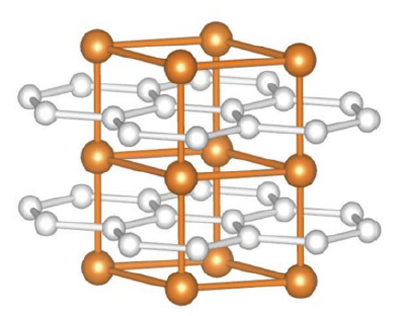 Illustration of the predicted simple hexagonal, or sh, electride structure of magnesium at eight megabars of pressure. The sh-arrangement of the magnesium ions is highlighted by the gold spheres, while the white spheres represent electron non-nuclear maxima (NNMs) localized in the material’s interstitial sites.
Illustration of the predicted simple hexagonal, or sh, electride structure of magnesium at eight megabars of pressure. The sh-arrangement of the magnesium ions is highlighted by the gold spheres, while the white spheres represent electron non-nuclear maxima (NNMs) localized in the material’s interstitial sites. Electrides are phases in which core and valence electrons bond and quantum-mechanical effects constrain the movement of valence electrons that have been freed from their nucleus. When a material is put under extreme pressure, clusters of those electrons can occupy a normally unoccupied, or interstitial, site in the material’s crystal structure. These density-induced localized “clumps” of electrons on interstitial sites are known as non-nuclear maxima (NNMs) and can result in electride structures (the NNMs act as almost massless “pseudo-ions”).
“Basically, you start to get ionic-like behavior within an elemental solid,” Gorman said, “and that can have really drastic effects on the material’s optical and electronic properties.”
Despite many computational predictions, the actual experimental evidence for high-density electrides had been limited to low-pressure (less than two Mbars) static compression studies of sodium and lithium. The predictions for the behavior of the electride phases of magnesium are clear, however, and—possibly uniquely—all are calculated to be metallic.
The NIF magnesium experiments use ramp, or shockless, compression combined with the TARDIS x-ray diffraction diagnostic to identify the phase transitions. Ramp compression is made possible by NIF’s ability to fine-tune the energy of its lasers so a sample can be compressed to extreme pressures without melting. “We can only do these experiments on NIF,” McMahon said. “NIF has the laser power to get to very high pressures while also having the pulse-shaping capabilities essential for ramp-compressing a highly compressible metal like magnesium and keeping it in a cool but compressed state.”
In the most recent experiment earlier this month—the fifth in the six-shot campaign—the magnesium sample, sandwiched between layers of beryllium and diamond, was subjected to 12 Mbars of pressure. A germanium x-ray source sent data to the TARDIS diagnostic, where the x-ray diffraction patterns were registered on image plates.
“The diffraction data that we’ve collected suggests that the structures we’re forming are more complex than previous theoretical studies predict,” Gorman said. “We’re pretty confident in what we see.”
More Complex Phases
In addition, he said, new calculations by LLNL’s Stanimir Bonev that take into account the bonding role of magnesium’s core electrons have produced a phase diagram “very different (from) the simple picture that has been presented before, and actually does point to distorted, more complex cubic-like phases being formed at high pressure.”
“We saw only a couple of diffraction peaks at 12 Mbars,” McMahon added, “but they were where we expected them to be according to the predicted structure at this pressure, so it seems that we’re on the right track. We’re working well with theory and while it’s in its early stages, it looks like we’re going to be able to figure out what these phases are—and it certainly seems that the high-pressure phase diagram of magnesium has to be, and hopefully will be, revised.
“It’s very complex behavior, and it’s so difficult and so rarely seen experimentally that we’re at the very beginning of really getting a handle on understanding how this behavior happens.”
The final experiment in the current campaign is scheduled for early May. “In our final shot,” McMahon said, “we will concentrate in getting the highest quality data at about four Mbars in order to tie down some behavior we saw in our first two shots.” The researchers believe the results ultimately could lead to a new view of the periodic table of elements and the discovery and control of new material properties, both at extreme and potentially even at standard conditions.
Joining McMahon, Gorman, and Bonev on the team are Amy Jenei, Jon Eggert, Rick Kraus, Dave Braun, Richard Briggs and Federica Coppari of LLNL, along with Rip Collins and Ryan Rygg at the Laboratory for Laser Energetics at the University of Rochester, and collaborators from the University of Edinburgh, the University of Oxford in the UK, and the UK’s Atomic Weapons Establishment.
—Charlie Osolin




